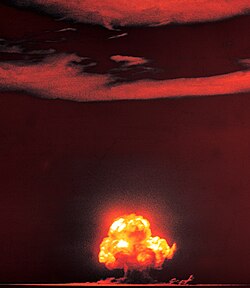Orel-1
This article is incomplete because it is pending further input from participants, or it is a work-in-progress by one author. Please comment on this article's talk page to share your input, comments and questions. Note: To contribute to this article, you may need to seek help from the author(s) of this page. |
| Orel-1 | |
|---|---|
 The mushroom cloud created by Orel-1 in 1956 | |
| Information | |
| Country | |
| Test series | Orel |
| Test site | near Vaara, Kantemoshan FSR, UPSR (now Vaara, Kantemosha and Ambrazka |
| Date | June 16, 1956 |
| Test type | Atmospheric |
| Device type | Plutonium-pit implosion fission reaction |
| Yield | 25 Kt (approx. 105 TJ) |
| Test chronology | |
Orel-1 or Orel I (Soravian: Орел-1; Orel-1) was the first in a series of nuclear weapons tests conducted by Soravia on the northern portion of the Hassi valley near the town of Vaara between 1956 and 1957 and was the first successful nuclear test carried out by the Soravian Army. It was detonated at 6:17 a.m. on June 16, 1956 by the army on a damp permafrosted plain in the valley, the site of many of the Orel tests. The town was evacuated prior to the test, and was almost entirely destroyed by the blast.
The code-name for the detonation, Orel, is Soravian for "eagle" and was suggested by influential Soravian fission experimenter and scientist Sergei Semenov in 1955 and was adopted in the same year for his outstanding contributions to the project. The test was an implosion-based plutonium fission device, a design that would remain unchanged until Orel-6 in 1968. The design's complexity led to divisions with the Soravian government and armed forces as to whether funding for the test should continue and whether or not it would work. President Vladislav Pudovkin and his successor Gabriel Tozulyak both chose to continue the project throughout the 1950s, although it required significant contributions from scientific test facilities and laboratories across the country.
A steel containment vessel was created to house Orel-1 before it was tested to contain the plutonium for re-use should a fizzle occur, and unlike its counterparts, the containment vessel was used when the bomb was detonated. No rehearsal for the test occurred and bomb was cleared for detonation at 5:57 a.m. on June 16, releasing an explosive yield of 25 kilotonnes of TNT, the largest test in history at the time. A number of scientists and nuclear experimenters from throughout Euclea observed the explosion. The crater caused by the explosion now serves as a historic landmark in the Hassi valley that is regularly visited by tourists.